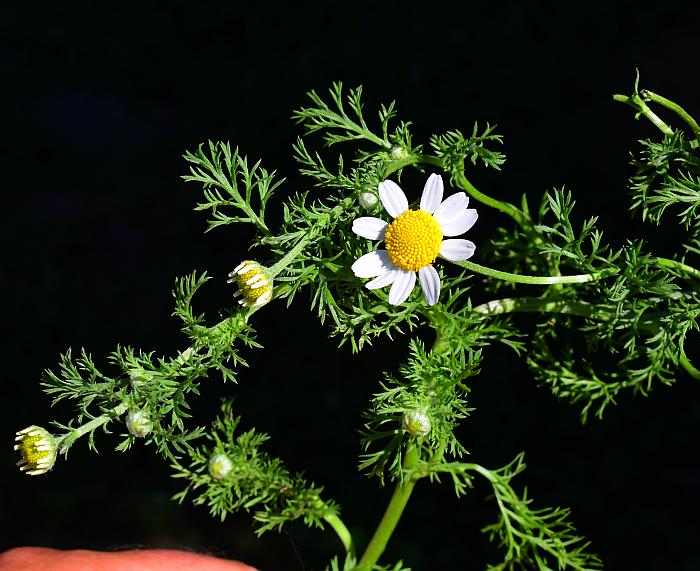Anthemis cotula L.
Stinking Chamomile, Dog Fennel

Introduced
CC = *
CW = 3
MOC = 50
© SRTurner
Anthemis cotula L.Stinking Chamomile, Dog Fennel | |
 |
Introduced CC = * CW = 3 MOC = 50 |
© SRTurner |
|
Family - Asteraceae/Anthemideae Habit - Taprooted annual forb, aromatic with an unpleasant odor. Foliage sparsely to densely pubescent with somewhat appressed, sometimes 2-branched hairs. Stems - Ascending to erect, to 50 cm, finely ridged, usually branched above the midpoint.
Leaves - Basal and alternate, deeply lobed. Basal leaves often wilted at flowering time. Blades 1-6 cm long, oblanceolate to elliptic or ovate, deeply 2 or 3 times pinnately lobed, the basal lobes sometimes appearing fascicled, the ultimate segments linear, 0.5-4.0 mm long, sharply pointed, mostly 1-veined.
Inflorescences - Solitary heads at branch tips, the stalks 3-8 cm long at flowering. Heads - Radiate. Involucre cup-shaped to hemispheric, 2.5-5.0 mm long, the bracts more or less in 2 or 3 loosely overlapping series, the outer ones somewhat shorter, elliptic-lanceolate to narrowly oblong or narrowly ovate-triangular, rounded to bluntly pointed at the tip, sparsely to moderately hairy, tan to brown, often with a narrow, green or brown midvein, the midrib not keeled, the margins broad, thin and papery, somewhat irregular to unevenly fringed. Receptacle hemispheric at flowering, elongating to conical or cylindrical at fruiting, solid, with chaffy bracts confined to the central portion.
Flowers - Ray florets 10-20, sterile, the corolla white, 5-9 mm long, sometimes inconspicuously glandular. Disc florets perfect, numerous, the corollas yellow, 1.5-3.0 mm long, the 5 lobes often minutely glandular. Pappus absent or a very short collar.
Fruits - Achenes 1-2 mm long, the ribs appearing strongly cross-wrinkled or tubercled, often also with glands between the ribs. Flowering - May - October. Habitat - Forest openings, streambanks, fields, orchards, barnyards, ditches, railroads, roadsides, open, disturbed areas. Origin - Native to Europe. Lookalikes - Anthemis arvensis, Matricaria chamomilla, Tripleurospermum inodorum. Other info. - This small daisy-like plant is found in scattered localities throughout much of Missouri and much of the continental U.S., though it is rare or absent in much of the Plains and (Rocky) Mountain areas. It is recognized by its small, daisy-like flowering heads and highly dissected foliage which emits a foul odor when bruised. This latter trait is probably the fastest means of differentiating the plant from its lookalikes, which it strongly resembles. More technical characters include the solid, conical receptacle, sterile ray florets, and presence of narrow, awl-like chaffy bracts toward the center of the head. Photographs taken at the Whiskey Creek Sheep Farm, near Krakow, Franklin County, MO, 6-16-2021 (SRTurner). |